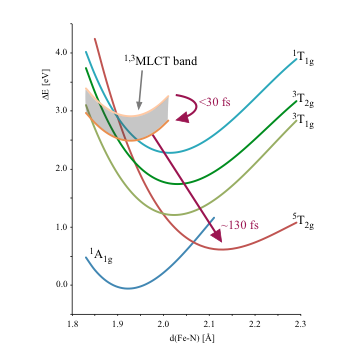Ultrafast Deactivation Mechanism of the Excited Singlet in the Light-Induced Spin Crossover of [Fe(2,2’-bipyridine)3]2+
Ultrafast Deactivation Mechanism of the Excited Singlet in the Light-Induced Spin Crossover of [Fe(2,2’-bipyridine)3]2+.
C. Sousa, C. de Graaf, A. Rudavskyi, R. Broer, J. Tatchen, M. Etinski, C. M. Marian
Chem. Eur. J. 19 (2013) 17541

The mechanism of the light-induced spin crossover of the [Fe(bpy)3]2+ complex (bpy = 2,2’-bipyridine) is studied by combining accurate electronic structure calculations and time- dependent approaches to calculate intersystem crossing rates. We determine all the intermediate electronic states along the pathway from low-spin to high-spin and give estimates for the deactivation times of the different stages. This strategy allows us to unravel the mechanism of the process. The calculations result in a total deactivation time on the same order of magnitude as the experimentally determined rate, in the range of 130 fs, and indicate that the complex can reach the final high-spin state via different deactivation channels. The optically populated excited singlet state rapidly decays to a triplet state with an Fe-d6(t2g5eg1) configuration either directly or via a triplet MLCT state. This triplet ligand field state could in principle decay directly to the final quintet state, but a much faster channel is provided by internal conversion to a lower-lying triplet state and subsequent intersystem crossing to the high-spin state. The deactivation rate to the low-spin ground state is much smaller, in line with the large quantum yield reported for the process.
